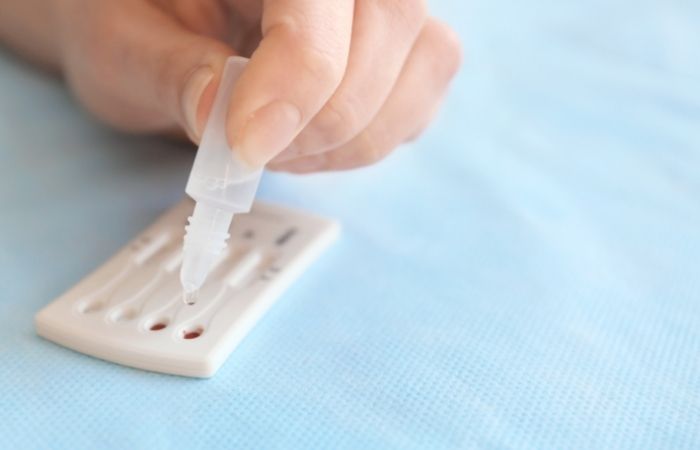Quick Answer: Yes. STDs can appear months or even years after the initial exposure due to dormancy, delayed detection, or testing errors, without any new sexual contact.
“We’ve Been Exclusive for Six Years. I Still Tested Positive.”
Alex, 31, remembers every detail of the phone call. “I had gone in for what I thought was a lingering UTI. My doctor suggested an STD panel just to be safe. When I saw the result, I froze. My partner was in the other room. How was I going to tell them?”
“The first thing I thought was, he must have cheated. But part of me also felt sick because I didn’t want to accuse him without proof. I wanted a medical explanation, but no one had ever talked to me about STDs this way.”
The truth is that sexually transmitted diseases aren’t always immediate or obvious. Some infections can live in your body silently, without symptoms, for months or even decades before they’re detected. Others might be missed by earlier tests and only show up later. And yes, sometimes the very tests meant to reassure you can produce false positives.

People are also reading: The Silent Spreaders: Why Some People Don’t Show STD Symptoms
Symptoms That Send People Googling at 2 A.M.
Many people arrive at this question because they’ve noticed something new, burning during urination, an unusual discharge, spotting after sex, or because a partner’s test came back positive out of nowhere. Others have no symptoms at all, but a routine screen turns up an unexpected result.
Chlamydia, gonorrhea, and trichomoniasis are infamous for being silent in the majority of cases. Herpes may lurk unnoticed until a period of stress or illness triggers a flare-up. Syphilis can lie dormant for years between stages. HIV can remain undetectable for weeks to months after exposure, depending on the test used. In each of these scenarios, a positive result can feel like a bomb dropped into a relationship, but it’s not always a sign of infidelity.
Latency, Dormancy, and the Long Game of STDs
Latency is the period between when an infection enters your body and when it becomes detectable or symptomatic. Some STDs, like herpes, establish permanent residence in nerve cells, reactivating unpredictably. Others, like chlamydia, can persist in a low-grade state that evades detection until something changes in your body’s environment.
A CDC report confirms that certain bacterial STDs can remain in the body without causing obvious harm for extended periods. This means someone could have contracted an infection before your relationship even began, never had symptoms, and only now be seeing a positive test.
What flips the switch from dormant to detectable? It might be a change in your immune system from stress, illness, or another infection. It could be antibiotic use altering your natural microbiome and making it easier for a low-level infection to resurface, something researchers have observed in both bacterial vaginosis and chlamydia cases.
When the Test Itself Isn’t the Final Word
Testing accuracy is another piece of the puzzle. Even though modern STD tests are very accurate, no medical test is perfect. There can be false positives, which is when the test finds something that isn't there. This is more likely to happen with some blood tests for herpes and syphilis. Results can be wrong because of cross-reactivity, sample contamination, or a mistake in the lab.
This is why doctors often suggest a confirmatory test if you get a result that you didn't expect. The Mayo Clinic, for instance, says that if the first herpes test result is surprising or doesn't match the symptoms, you should test again using a different method.
In short, one test isn't enough to tell the whole story, and you should double-check a positive result before making any big decisions.
Check Your STD Status in Minutes
Test at Home with Remedium8-in-1 STD Test Kit

 For Men & Women
For Men & Women Results in Minutes
Results in Minutes No Lab Needed
No Lab Needed Private & Discreet
Private & DiscreetOrder Now $149.00 $392.00
For all 8 tests
The Science of Dormant and Delayed STDs
To understand why an STD can appear long after you thought you were “safe,” it helps to know how different pathogens behave in the body. Not all infections follow the same rules. Some burn fast and bright, showing symptoms within days. Others play the long game, lying low for months or even decades.
Chlamydia is known for being quiet; up to 70% of infected women and 50% of infected men don't show any signs. In a study published in Sexually Transmitted Infections, researchers found that chlamydia can stay in the cervix for more than a year without causing any obvious symptoms, especially in people who haven't had regular screenings. It might not be "new." It could have been there quietly since before your current relationship.
After the first infection, the herpes simplex virus (HSV) can hide in nerve cells and come back to life years later. You might not remember the first time you got it, especially if the first time it happened was mild or you thought it was something else, like razor burn. According to the CDC, reactivation can happen at any time, and it can be caused by stress, illness, or even changes in hormones.
There is a latent stage of syphilis that can last for years without any symptoms. Blood tests can still find it during this time, even though the person may feel fine. The World Health Organization (WHO) says that latent syphilis is common and doesn't always mean that someone has recently been infected.
There is a "window period" for HIV between when a person is exposed and when tests can find it. This period can last anywhere from 10 days to 3 months, depending on the type of test. This delay can cause confusion about when and where the infection came from, even though it isn't technically dormant in the same way.
“The Timeline Didn’t Make Sense”
Marisol, 27, got her diagnosis on a sunny Tuesday afternoon. “I’d gone in for birth control renewal, and my nurse suggested an STD panel just because it had been a while. I said yes without thinking. When the result came back positive for gonorrhea, my mind went straight to betrayal.”
“But the more I researched, the more I realized it could’ve been in my system for months. I’d had no symptoms, and my last test had been almost two years ago. My partner’s test came back negative, and the doctor said it’s possible my infection cleared naturally in him but lingered in me.”
Her story is messy, complicated, and human, just like the biology of STDs themselves. Not every diagnosis has a clear-cut cause-and-effect timeline, and assuming it does can harm relationships unnecessarily.

People are also reading: Busting the Myths About STDs
False Positives: When the Test Isn’t the Truth
It’s uncomfortable to admit, but lab tests aren’t infallible. False positives happen for a variety of reasons, technical errors, cross-reactivity with other proteins, or even clerical mix-ups. The Journal of Clinical Microbiology documents how certain herpes and syphilis tests can produce false positives, particularly in low-prevalence populations where the statistical likelihood increases.
This is why medical guidelines stress confirmatory testing before any major relationship or health decisions are made. A retest using a different method can often clarify whether the first result was accurate.
Myth-Busting the “Cheating Equals Positive Test” Assumption
The cultural script is painfully familiar: an STD diagnosis automatically means someone stepped outside the relationship. But this narrative ignores decades of epidemiological data, clinical experience, and microbiology. The truth is far messier, and far more common, than the soap opera version we’ve been sold.
According to Planned Parenthood, many STDs are asymptomatic for long periods, and infection timelines can’t be pinpointed to the week or even the year in some cases. This means a positive test in year five of your relationship could be linked to an exposure from year zero, or earlier.
Stigma’s Collateral Damage
In exam rooms and bedrooms alike, the unspoken rule is that suspicion comes before science. Couples sit in front of clinicians, one accusing, the other defending, and the infection itself becomes secondary to the emotional fallout. Relationships end not because of the infection’s danger, but because of the mistrust it’s wrapped in.
David, 42, still remembers the look on his wife’s face when she saw his herpes test result. “I felt like I was on trial for something I didn’t do. When the doctor explained it could’ve been in my system for decades, I saw her shoulders drop. But we still had to rebuild trust from scratch.”
“I wish more people understood that bodies are messy. Infections don’t keep neat calendars.”
How Myths Keep People From Getting Tested
Fear of the “cheating” label stops countless people from seeking routine STD screenings, especially in long-term relationships. Some avoid testing altogether, convinced that the act of getting tested will spark suspicion in their partner. Others wait until symptoms are too obvious to ignore, which often means the infection has already caused damage.
This isn’t just bad for relationships, it’s bad for public health. The CDC notes that untreated STDs can lead to infertility, chronic pain, and increased risk of HIV. The longer infections go undetected, the harder they are to treat, and the greater the chances of transmission to others.
Check Your STD Status in Minutes
Test at Home with RemediumHepatitis B & Hepatitis C Test Kit

 For Men & Women
For Men & Women Results in Minutes
Results in Minutes No Lab Needed
No Lab Needed Private & Discreet
Private & DiscreetOrder Now $49.00 $98.00
For all 2 tests
The Test That Saved a Marriage
Two years into their marriage, Sophie and Mark decided to get tested together, “just to be thorough” before trying for a baby. When Sophie’s results showed latent syphilis, the shock was immediate. “We hadn’t been with anyone else. We almost didn’t believe the lab.” A follow-up test confirmed it had likely been dormant for years, long before they met. The treatment was simple, a round of antibiotics, and they both walked away not only cured but closer, grateful they’d faced it together instead of apart.
Their story is the opposite of the betrayal narrative: testing didn’t break their trust; it proved it.
Shifting the Lens: From Accusation to Curiosity
Couples can work together instead of fighting when they see an unexpected STD diagnosis as a medical puzzle instead of a moral failure. This change in thinking can turn a possible breakup into a shared health journey, with clearer communication, better ways to avoid problems, and often a new respect for how willing each person is to face uncomfortable truths.
Here is where sex positivity becomes important: recognizing that bodies are complicated, that sexual history is part of health history, and that testing is a normal, responsible thing to do, not an accusation in disguise.

People are also looking for: The Breakthrough HIV Injection You Need to Know About
Testing Without the Drama
At-home STD test kits can be a private way to get tested if you don't want to go to a clinic or if the idea of going to one makes you anxious. You can check for several common infections with just one sample using kits like the 6-in-1 STD At-Home Rapid Test Kit. You don't even have to leave your home. This is a great choice for couples who want to get checked out regularly but don't want to deal with the stress of an appointment.
Testing isn't just about finding problems; it's also about confirming good health. Being aware of your status gives you the information you need to make smart decisions about your sex life, plans for having children, and long-term health.
FAQs
1. Is it possible for STDs to stay dormant for years?
Yes. Herpes, syphilis, and HPV can stay in the body for years without showing any signs before they are found.
2. Why did my partner test negative when I did?
Infections may go away on their own in one person but stay in another, or your partner may be in a window period before they are detected.
3. Is it possible that my positive test is wrong?
It's possible to get a false positive, but it's not very likely. Always double-check unexpected results with a second test.
4. Do I need treatment if I don't have any symptoms?
Of course. Even if you don't present symtomps, untreated STDs can cause long-term health problems and be passed on to other people. If you know you have an STD, the best course of action is to always get treated.
5. How often should couples who are monogamous get tested?
At least once a year, or sooner if symptoms show up or there was a chance of exposure before the relationship started.
6. Can stress make an STD show up?
Yes, but not directly. Stress can make your immune system weaker, which can cause viruses that are already in your body, like herpes, to wake up and become detectable.
7. Why do some STDs stay secret?
Some germs can live in parts of the body where the immune system can't completely get rid of them. For example, herpes can live in nerve cells and syphilis can live in deep tissues.
8. Could my partner have had the STD before we met?
Of course. Many STDs can stay dormant for months or even years, so you could have had an infection before you started dating.
9. Can antibiotics make an STD show up?
Kind of? Stress doesn't cause STDs, but it does make your immune system weaker, which in turn makes it more vulnerable to viruses and can cause those already inside your body to flare up.
10. Should both partners get treatment if only one tests positive?
Most of the time, yes. Treating both partners stops the infection from spreading and makes sure that no one unknowingly carries it.
You Deserve Answers, Not Accusations
When you find out you have an STD while in a committed relationship, it's a very emotional time. But trust doesn't have to die because of it. Couples can get through the shock and come out stronger if they have the right information, do confirmatory tests, and talk to each other openly.
Sources
1. Planned Parenthood – STDs, HIV, and Safer Sex
2. Sexually Transmitted Infections Journal – Chlamydia Persistence Study
4. Frontiers in Cellular and Infection Microbiology – BV and Chlamydia Persistence










